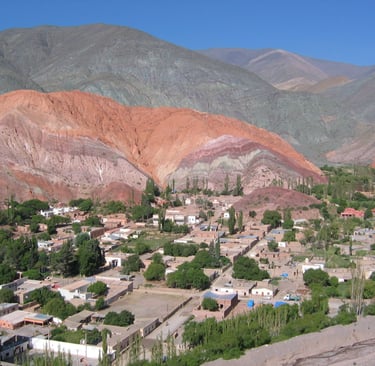Jujuy: A Palette of Altitude, Ancestry, and Silence
Jujuy is a land of painted hills, ancient trails, and living ritual—where silence teaches, salt deserts shimmer, and Andean spirit lingers in every breath of wind
TOURISMTRAVEL GUIDEJUJUY
Gabriela Arellano
7/18/20253 min read


Jujuy is not made to be seen all at once. It reveals itself like an old song: slowly, deeply, with verses hidden between the wind and the mountain. Here, the earth is not just ground—it is a canvas, a shrine, a memory.
Before roads stitched the Andes, the Omaguacas, the Atacamas, and the Quechuas called these valleys home. They carved terraces into the slopes, left offerings on mountaintops, and spoke with the land in ways we still don't fully understand.
🌿 Quebrada de Humahuaca: A Corridor of Color and Time
The Quebrada de Humahuaca isn’t just a valley—it’s a living archive. Once a vital link in the Inca trail, it now carries stories in stone and dust.
Recognized as a UNESCO World Heritage Site, the quebrada is more than scenery—it is memory made landscape, where history ripples through ravines and rituals still echo between the cliffs.
The villages—Purmamarca, Tilcara, Humahuaca, and Uquía—breathe slowly, rhythmically, like prayers said under breath.
· Purmamarca: Home to the Cerro de los Siete Colores, a hill that rises like a frozen fire, painted by minerals and millennia.
At dawn, its layered ridges—red, white, lavender, yellow, and green—glow with a quiet that feels sacred. The hill exhibits this range of colors thanks to the presence of different minerals in its composition: red from red clay and mud, white from limestone, lavender from sandy marls, yellow from limonite, and green from clay and copper oxide.
It’s not just a view; it’s a lesson in geological time, in the patience of beauty shaped over millions of years.
· Tilcara: With its pre-Hispanic fortress, Pucará de Tilcara, and vibrant artisan life, it balances history and now with quiet grace.
· Humahuaca: Where the north feels strongest. Streets of cobble and cactus, music carried in air too thin for excess.
🛶 Procession on Water: El Carmen’s Serenata
Just beyond the Quebrada, in the town of El Carmen, tradition takes to water. Every July 15th, on the eve of the Fiesta Patronal of the Virgen del Carmen, the town gathers by the mirror-like surfaces of La Ciénaga and Las Maderas. A Serenata rises into the night—guitars, voices, devotion. Then, as if time had stilled, a procession of boats begins: catamarans and canoes adorned in celeste, white, and yellow, gliding with reverence.
The Virgin crosses the water, her people behind her, not walking—floating. It is not a spectacle. It is a moment of breath held between earth and heaven.
🌲 Altitude as a Teacher: Salinas Grandes and Beyond
Climb higher still, along the sinuous Cuesta de Lipán, and you arrive at the Salinas Grandes—a white horizon where salt glitters like a mirage and the sky feels closer than your thoughts. It is not a place to walk quickly.
Here, every step speaks. Every silence echoes. And somewhere between the brightness and breathlessness, you remember how little—and how full—you are.
⛪ Sacred Roots and Living Culture
In Jujuy, traditions are not preserved behind glass. They are lived. Shared in dances during the Fiesta de la Pachamama (Mother Earth), whispered in markets heavy with woven colors, or burned in the fire of the Carnaval de Tilcara, where masks and music push past the visible world.
You’ll find them, too, in the earth itself—where locals prepare communal meals by burying food in underground holes, a practice as ancient as the mountains. Wrapped in leaves and covered with hot stones, meats, corn, and potatoes cook slowly in the belly of the land, a ritual of nourishment and reverence.
This is not folklore—it is a survival, a wisdom that feeds both body and spirit. A joy that remembers.This is not folklore—it is a survival. A joy that remembers.
🍽 Where to Eat
El Nuevo Progreso (Tilcara): Creative regional cuisine with Andean soul.
Pedro Pan (Purmamarca): Humitas, locro, llama meat—earth on a plate.
Pacha Manka (Humahuaca): Simple, slow, real.
🏨 Where to Stay
El Manantial del Silencio (Purmamarca): Colonial elegance and deep quiet.
Casas de Juella (Tilcara): Warm adobe, deep rest.
Hostal La Soñada (Humahuaca): Honest, local, unforgettable.
⚖️ Let the Colors Speak
Jujuy isn’t a destination—it’s a ritual. A place that doesn’t change for you, but allows you to change within it.
Come with silence. Leave with something you didn’t know you’d lost.


Explore more posts in our Travel category
Know Argentina
Discover diverse insights about Argentina's rich culture.
Connect
stay in the loop
info@knowargentina.com
© 2025. All rights reserved.
